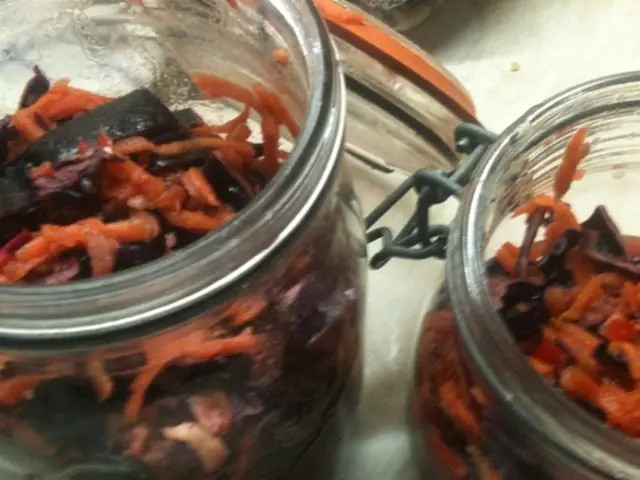Vibrant Polish Pisanki Crafting: A Chromatic Easter Festivity Tradition
In the heart of Polish Easter celebrations, you'll find the enchanting art of Pisanki - intricately decorated eggs that symbolize the country's rich culture and spirituality. These aren't your average Easter eggs; they're masterpieces of art, tradition, and spirituality, deeply rooted in Polish Easter festivities. This article dives into the world of Pisanki, uncovering their origins, significance, and their place in modern habits.
Pisanki are breathtakingly adorned eggs, crafted by emptying the eggshell and meticulously painting it with complex designs and patterns. The name "Pisanki" stems from the Polish verb 'pisać', which traditionally meant 'to paint'. The ornate designs carry hidden meanings, expressing wishes for health, fertility, and abundance.
Fun Fact
The tradition of egg decoration predates Christianity, with roots in Slavic paganism. Eggs, as symbols of new life and renewal, were integral to spring rituals celebrating the earth's reawakening after a long winter. With Christianity's arrival, the tradition was adapted to represent the resurrection of Jesus Christ and the promise of eternal life.
Over time, Pisanki's artwork evolved, absorbing various techniques and styles, each region in Poland developing its unique patterns and methods.
Techniques and Styles
Creating Pisanki involves several techniques, with traditional methods including:
- Kraszanki: Simple colorful eggs dyed using natural dyes from everyday items like onion peels, beetroot, or walnut shells.
- Wax-Resist Method: Intricate patterns are drawn on the eggshell with melted beeswax, which, after dyeing, is removed to reveal the design.
- Scratching Technique: Complex designs are etched on the dyed eggshell, revealing the white underneath.
- Batik Method: Similar to the wax-resist method, this involves multiple layers of wax and dye to create multicolored designs.
In today's world, Pisanki still play a crucial role in Polish Easter celebrations. Modern practices see families gathered in making their Pisanki, cultivating a sense of unity across generations. Workshops and exhibitions are common, giving artisans and crafters the chance to explore traditional and contemporary patterns, ensuring Pisanki's art form lives on.
Global Appeal
In recent years, Pisanki have gained prominence in global Easter celebrations, symbolizing rebirth and universal life themes. They serve as a cultural symbol of Poland, showcasing the country's rich traditions and artistic heritage.
With growing interest in sustainability and handmade crafts, Pisanki provide a connection to nature and tradition. The use of natural dyes and emphasis on handcrafting resonate with contemporary movements focusing on mindfulness and environmental consciousness. Moreover, Pisanki making offers a moment of calm and reflection, inviting both artists and beginners to explore creativity in a meditative manner.
As Polish communities around the world prepare for Easter, Pisanki remain a colorful testament to the enduring power of cultural traditions. They celebrate shared human experiences, reminding us of our quest for light amid darkness, warmth amid cold, and life amid death. In Poland and beyond, the tradition of Pisanki continues to weave a vibrant thread through Easter celebrations, linking the past, present, and future.
Subscribe to Newsletter
Every Saturday
We don't spam!
Check your inbox or spam folder to confirm your subscription.
Pisanki—a timeless, enchanting practice that bridges Poland's pagan roots and Christian beliefs, continues to thrive as a beacon of cultural heritage inspired by the colors of renewal and spring.
- AI technology may help in the design of contemporary Pisanki, infusing traditional art with modern creativity.
- In the realm of fashion-and-beauty, Pisanki-inspired clothing or accessory designs can be seen as a reflection of Poland's rich lifestyle and cultural influences.
- As the weather warms up, you can find vendors selling handmade Pisanki at local farmers markets, offering a taste of food-and-drink festivals and home-and-garden exhibitions.
- The creation of Pisanki can be satisfying for personal-growth and education-and-self-development, teaching patience, focus, and craftsmanship.
- In a bustling cityscape, a policeman's rookie year may lead to some challenging career-development situations, much like the complex designs of traditional Pisanki.
- Admittedly, caring for pets can sometimes feel like a war—a daily struggle to maintain harmony within the household. However, the bond shared with our furry companions can provide immense health benefits and nurturing relationships.
- While traveling the world, it's captivating to encounter cultural practices like Pisanki that showcase the rich diversity of human traditions.
- During the car race season, drivers often find themselves under intense pressure, requiring unwavering focus, dedication, and balance—mirroring the meticulous attention needed to create intricate Pisanki designs.
- With the rise of e-commerce platforms, Pisanki can be purchased online for shopping enthusiasts seeking to add a touch of Polish culture to their homes and lifestyles.
- Remember that relationship issues can sometimes feel like an uphill battle, but learning from one another and supporting each other throughout the process can help strengthen the bond between you, akin to the connection between Pisanki's complex designs and their powerful symbolism.
- Sports competitions, like a marathon or a soccer match, can be thought of as a personal journey towards self-improvement and growth, similar to the growth and learning experienced while creating or appreciating Pisanki.
- In a world filled with fast-paced changes and technology, Pisanki remains a humble reminder of simple pleasures, offering solace and connection with nature, tradition, and spirituality—a bond worth cherishing in our ever-evolving lifestyle.










